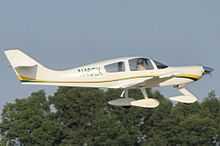Wheeler Express
| Express | |
|---|---|
 | |
| Role | Experimental Aircraft |
| National origin | United States |
| Manufacturer | Wheeler Technology Express Design Express Aircraft Company |
| Designer | Ken Wheeler |
| First flight | 28 July 1987 |
| Introduction | 1984 |
| Unit cost |
$19,975 for kit without engine and avionics in 1989 |
| Variants | Express Series 90 |
The Wheeler Express (or later known as EDI Express) is a four-seat low-wing composite homebuilt aircraft.

Development
Developed by Wheeler Technology as a high-speed homebuilt aircraft for cross-country flights and the first of the kit built prototypes was first flown on 28 July 1987, a factory built aircraft first flew in 1990. Wheeler Technology went into bankruptcy and the assets were bought by Express Design Incorporated (EDI) of Redmond, Oregon. Kits that were under construction were completed by EDI and they continued with kit production. A six-seat variant was produced by EDI as the Loadmaster 3200.
By the late 1990s the aircraft was being produced by Express Aircraft Company in Olympia, Washington[1]
Design
The composite compound curve fuselage was chosen to reduce the number of stiffeners and stringers needed. The design used an unusual seating position where one rear seat faced forward and one aft to maximize interior space. The fuselage was built with similar construction methods to Glasair aircraft.[2] The aircraft was only produced in kit form with five main packages that included precut ribs, preweled steel assemblies, and a spar prebonded to the upper wing surface.[3]
The cabin width is 46 in (120 cm).[1]
Operational history
A crash of an early example of the Wheeler Express was said to demonstrate the airframe's safety due to the energy absorption during the non-fatal crash.[4]
Variants
- Wheeler Express FT
- Fixed gear
- Wheeler Express RG
- Proposed retractable design
Specifications (Express Aircraft Company Express)
Data from Cavin and Purdy[1][5]
General characteristics
- Crew: one
- Capacity: three passengers
- Length: 26 ft 0 in (7.92 m)
- Wingspan: 31 ft 6 in (9.60 m)
- Wing area: 130.0 sq ft (12.08 m2)
- Airfoil: NASA NLF-1(0215)F
- Empty weight: 1,825 lb (828 kg)
- Gross weight: 3,200 lb (1,451 kg)
- Fuel capacity: 92 U.S. gallons (350 L; 77 imp gal)
- Powerplant: 1 × Lycoming IO-540 , 250 hp (190 kW)
- Propellers: 2-bladed constant speed propeller
Performance
- Maximum speed: 196 kn; 362 km/h (225 mph)
- Cruise speed: 191 kn; 354 km/h (220 mph)
- Stall speed: 47 kn; 87 km/h (54 mph) flaps down
- Service ceiling: 24,000 ft (7,300 m)
- G limits: +8.8 -4.4
- Rate of climb: 1,800 ft/min (9.1 m/s)
- Wing loading: 24.6 lb/sq ft (120 kg/m2)
References
| Wikimedia Commons has media related to Wheeler Express. |
- ↑ 1.0 1.1 1.2 Purdy, Don: AeroCrafter - Homebuilt Aircraft Sourcebook, Fifth Edition, page 153. BAI Communications, 15 July 1998. ISBN 0-9636409-4-1
- ↑ Dick Cavin (Nov 1987). "Wheeler Express". Sport Aviation.
- ↑ David Gustafson (August 1989). "Express Lane". Air Progress.
- ↑ Darrl Glover. "Saved By The Plane He Crashed Kit Aircraft's Design Cushioned Impact". Seattle Pi.
- ↑ Dick Cavin (Nov 1987). "Wheeler Express". Sport Aviation.
| ||||||||||||||||||||||